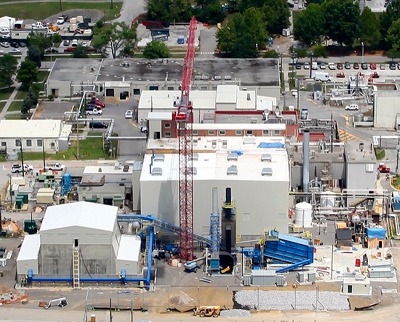
A new steam plant at Oak Ridge National Laboratory burns wood chips rather than fossil fuels, and officials say it will save energy and reduce greenhouse gas emissions. (Photo submitted by U.S. Department of Energy)
New energy conservation measures in place at Oak Ridge National Laboratory could save an estimated $200 million during a 25-year period, the U.S. Department of Energy announced this week.
The centerpiece of those measures is a biomass plant that burns wood chips and not fossil fuels to produce steam for heat and humidity control on the lab’s main campus, DOE said in a press release.
Officials had a dedication ceremony for the Central Biomass Steam Plant on Thursday.
Here’s more information from a DOE press release this week:
The U. S. Department of Energy’s (DOE) Oak Ridge National Laboratory (ORNL) Site Office dedicated its newly renovated Central Biomass Steam Plant, completing a project that positions the agency to meet federal energy efficiency, renewable energy, water conservation, and emission reduction goals.
The construction, which replaced four fossil fuel-fired boilers with a biomass—wood-burning—system, was performed through an Energy Savings Performance Contract (ESPC) with Johnson Controls, Inc. (JCI). In all, JCI identified eight Energy Conservation Measures (ECMs) to improve energy efficiency at the ORNL. The ECMs ranged from implementing energy-efficient lighting upgrades to replacing the aging central steam plant with a state of the art biomass gasification system supplied by Nexterra Systems Corp. In all, these ECM’s will save an estimated $200 million during the 25-year life of the project. The biomass steam plant project is the centerpiece and anchor of the ESPC.
Congress authorized ESPCs to better enable federal agencies to achieve energy efficiencies and conservation in federally owned facilities. ESPCs take the form of a partnership between a federal agency and an authorized energy service company (ESCO), which conducts an energy audit of the facility and designs and implements a comprehensive energy savings plan.
“This project demonstrates that public institutions and private companies can partner to supply innovative clean-energy technologies on a large scale,” said ORNL Site Office Manager Johnny Moore. “The biomass plant will also provide an opportunity for researchers to gather important data from a large-scale biomass process.”
ORNL’s steam plant generates steam for heat and humidity control on the lab’s main campus. The DOE selected JCI in 2007 to develop an ESPC for ORNL. Plant renovations began in 2008. The work focused on removing the plant’s four inefficient boilers and replacing them with a technologically advanced biomass gasification system that converts wood to synthetic gas (syngas). Biomass is a locally available, renewable form of energy. The use of biomass represents a shift away from finite and carbon-producing fossil fuels.
The biomass gasification technology and elimination of four fossil-fuel boilers reduces greenhouse gases equivalent to the emissions of 4,500 automobiles per year and models a sustainable solution to the nation’s energy needs.
The Central Biomass Steam Plant project also provides DOE researchers with a working demonstration of cutting-edge renewable energy operations in a large physical-plant setting. Moore cited the work of DOE’s BioEnergy Science Center, located at ORNL, as an example.
The biomass project required demolition and construction to be conducted while the utilities staff continued to provide steam to the ORNL facilities. JCI’s commitment to safety led to nearly 1,100 days without a lost time injury. “We care deeply about the health and safety of our employees and our customers’ employees,” said Project Manager Steve Page. “Customers can count on us to put safety first and get their job done right.”
Additional significant and sustainable environmental benefits resulting from the new plant include the biomass gasification system, which utilizes local woody biomass sourced within a 50-mile radius, energy, plus electrical savings, reduced water use, and reductions in greenhouse gases and pollutants.
For more information on DOE’s Energy Savings Performance Contracts program, see http://www1.eere.energy.gov/femp/financing/espcs.html.
Tj says
I love the way beaucrats talk about saving money.
In Washington, the savings are usually from the anticipated increased spending.
My first wife used to teel me she saved me money by buying the $100 pair of shoes instead ofbthe $200 pair.